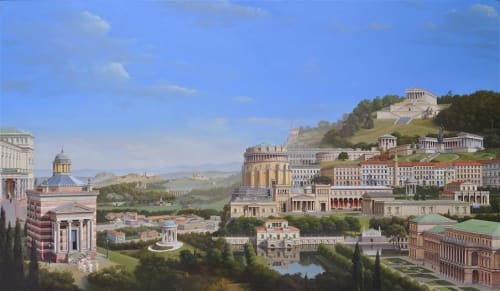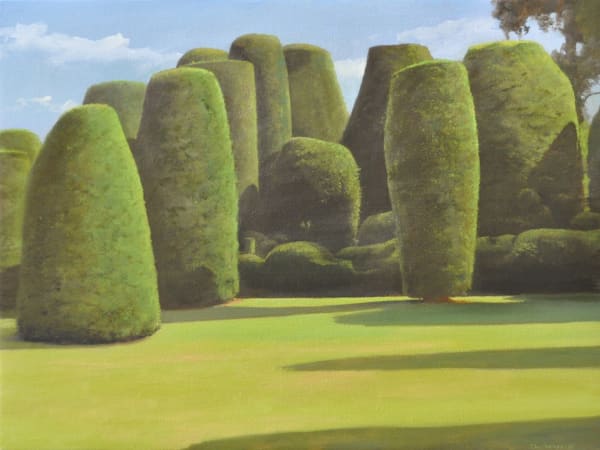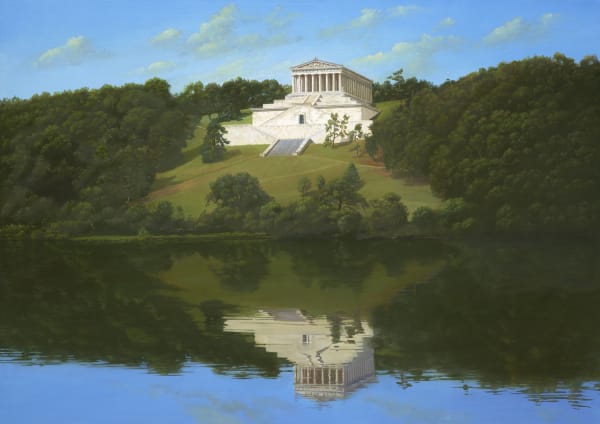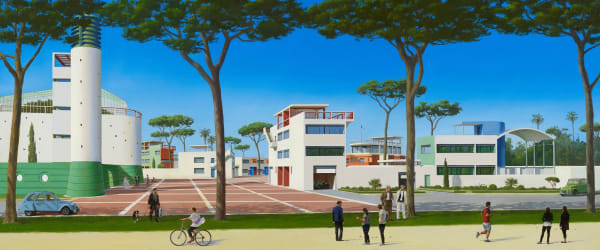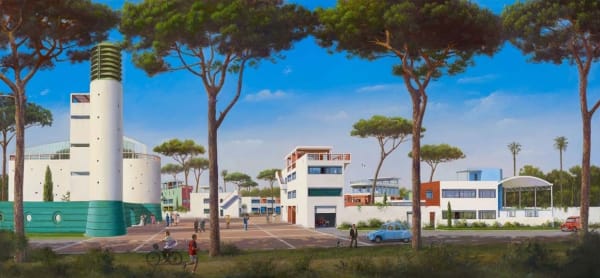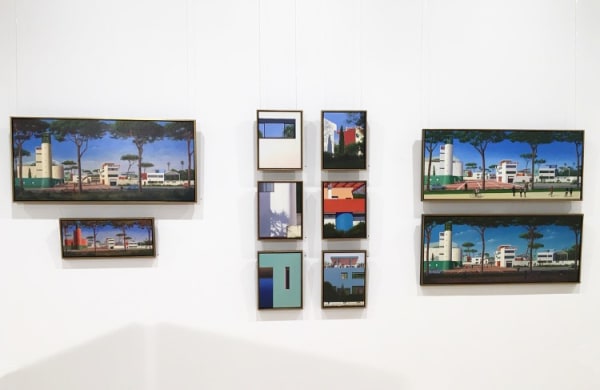Carl Laubin: A Sentimental Journey
Plus One Gallery is delighted to announce the forthcoming solo show 'A Sentimental Journey' by gallery artist Carl Laubin. This exhibition portrays Laubin's research and the passion he holds for the architecture, paintings and drawings of Leo von Klenze; Laubin's latest Capricci will be unveiled at this time. Included in the exhibition are paintings of a hypothetical project Léon Krier was working on based on Le Corbusier’s 1925 Pessac housing “revisioned”. The three main paintings are based on one of Léon’s sketches who has replanned the neighbourhood in Pessac.
We are also pleased to have as our guest of honour, opening the exhibition and holding the UK launch of his new guide to the built works of Leo von Klenze, Professor Adrian von Buttlar of the
Technical University Berlin. Professor von Buttlar, who studied in Munich and at London´s Courtauld Institute in the 1970's, is an authority on Leo von Klenze and has previously published a major biography and study of his work. Professor von Buttlar promises to give a brief talk revealing details of his discovery of von Klenze’s three visits to London.
Plus One Gallery is pleased to present an exhibition of paintings by Carl Laubin.
Laubin is a British/American artist, perhaps best known for his series of architectural capricci.
Born in New York in 1947, he later studied architecture at Cornell University before moving to London in 1973 and becoming a British citizen in 2000. He worked for a number of architectural firms in the UK, primarily Douglas Stephen and Partners and later Jeremy Dixon. It was Jeremy Dixon who encouraged Carl to make his first architectural paintings, which led him to illustrate the firm’s redevelopment of the Royal Opera House. By 1986 he was able to devote himself fully to painting.
His work has retained architecture at its centre and Plus One Gallery is excited to reveal the exhibition’s main work: “Klenzeana’”, a capriccio depicting the architecture of Leo von Klenze. Von Klenze was a nineteenth century German neoclassical architect, the Bavarian equivalent of the more widely known Prussian architect Karl Friedrich Schinkel, his near contemporary. Schinkel’s appeal to modern architects as a prototypical modernist has tended to eclipse Von Klenze’s reputation, as his work is much more firmly rooted in past styles, being a prominent advocate of the Greek Revival Style. Klenze’s architecture transformed Munich from a provincial town of 50,000 inhabitants into a major cultural capital, through a series of residential buildings expanding the city alongside a number of public buildings, art galleries and monuments, including the Glyptothek, a museum for antique sculpture that is one of the first public museums in the world. His planning of the expansion of Munich was astonishingly complex and sophisticated, linking the old town to an expansive, open, new sequence of squares and avenues which led one biographer to claim von Klenze had achieved Goethe’s ideal of raising architecture to a level where “On the most ordinary day the citizens feel themselves to be in an ideal state.”
Outside Munich, von Klenze built monuments celebrating the liberation of Bavaria from Napoleonic rule at Kelheim, which is the central building in the Klenzeana and a monument to the achievements of German speaking peoples, the Walhalla, above the Danube at Donaustauf. He built a small Orthodox chapel at Baden-Baden, The New Hermitage Museum in St. Petersburg and designed a number of buildings for Athens, only one of which, the Catholic Cathedral St. Dionysius, was built. He was also an early recipient of the Royal Institute of British Architects’ Gold Medal for Architecture in 1852. All these works find a place in Klenzeana and their representation in a single painting give an insight into the extent of the achievements of an architect, who should be more widely acknowledged. Although Klenze’s work has strong links with British neoclassical architecture, his work has not received the acknowledgement it deserves. Particularly Walhalla and the Monopteros, the setting of a temple in a naturalistic landscape, is an idea central to British architecture in the 18th century.
“Klenzeana” is truly an ode to the magnificent neo classical architect, Leo von Klenze.
A Sentimental Journey
“Journey” is a term I prefer to avoid in any context other than actually traveling from A to B as it is so overused (along with iconic). So I astonished myself when I settled on A Sentimental Journey as the title for this exhibition. I was reading Laurence Sterne’s satirical novel of that title about the 18th century Grand Tour, and it suddenly struck me that the title was very appropriate to my paintings of Leo von Klenze’s work in this exhibition, so steeped is his architecture in the study of antiquity from his journeys through France, Italy and Greece visiting many of the sites of the Grand Tour but studying them in a much more intense manner than that of a tourist. This journey was not just the mental or emotional journey of the clichéd term “journey” but actually did involve traveling to many of the major archaeological sites of antiquity and studying them through making sketches of the remains and drawing or painting reconstructions. It should also be pointed out, as the introduction to my copy of Sterne’s A Sentimental Journey does, that at the time of its writing in the mid 18th century, “sentimental” had a quite different meaning to what it does now. It “did not have the pejorative sense of ‘excessively emotional” or ‘mawkish’ that it has since acquired.” The meaning was more to do with being in a mood of reflection and of being in sympathy with the object of reflection. This is certainly evident in the beautiful drawings and paintings von Klenze made of his travels. I was given a book on von Klenze’s drawings and paintings by the architect Léon Krier back in 1987 when I was working on a painting of Krier’s Atlantis project. It was my introduction to this early nineteenth century Bavarian architect’s work. Von Klenze was a contemporary of Schinkel but is now less well known, hardly known at all in Britain. The book did not include much about his architecture but mainly focused on the drawings and paintings he made on his travels through Italy and Greece. I did not really appreciate the extent and beauty of his architecture until starting the research for these paintings. I have long admired the English architect C. R. Cockerell both for his architecture and his painting. He inspired my first architectural capricci with his paintings The Professor’s Dream and A Tribute to Sir Christopher Wren, which combine numerous buildings out of their contexts in imaginative compositions. I was interested to find that von Klenze was almost the exact contemporary of Cockerell and their careers have many similarities. They were both architects, painters, archaeologists and architectural theoreticians.They both received the Royal Gold Medal for Architecture from the Royal Institute of British Architects within four years of each other, so presumably von Klenze did have some following in Britain at one time. It is an interesting thought that von Klenze and Cockerell, as they formed their architectural styles, visited and drew many of the same archaeological remains in Greece and Italy. They shared a particular interest in the Temple of Olympian Zeus at Agrigento, both men having made measured drawings of the remains of the temple and drawings reconstructing the building and its Atlantes or giant columns in the shape of male figures. These feature in many of von Klenze’s designs including the Befreiungshalle and the Hermitage in St. Petersburg which can be seen in the paintings in this exhibition.
This study of antiquity on the Grand Tour links von Klenze to British architects like Cockerell , Sir John Soane, Stuart and Revett and many others from Europe and even the USA who shared at this time much common ground, across borders, in what was really an international style. The second group of paintings in this exhibition concerns that other International Style that emerged in the 1920’s. These paintings are small studies of Le Corbusier’s 1925 housing for workers in Pessac, Cité Henri Fruges. This French housing project, similar to Britain’s Garden Cities projects, was to provide affordable housing for the workers in Henri Fruges’ sugar refinery. There are also four variations on a painting depicting Léon Krier’s hypothetical project “revisioning” Cité Henri Fruges. This forms part of a larger Krier project to create a 9th volume of Le Corbusier’s Oeuvre Complete subtitled: “Le Corbusier after Le Corbusier”; LC Translated, LC Completed, LC Corrected. Léon Krier appears to be a unifying thread running through this exhibition, having introduced me to the work of von Klenze and initiating these Pessac paintings. To return to the title of this exhibition, A Sentimental Journey, sentimental is not a term generally associated with the architecture of Le Corbusier. However, I remember talking to Léon Krier at an RIBA exhibition, Three Classicists, in 2010. We were joined by someone who recounted having a well known modernist architect remark to him about the exhibition, “It would be fine if it were not sooo nostalgic”. I thought at the time that this architect’s own work was so permeated by Corbusian nostalgia that it could fill a whole new volume of Le Corbusier’s Oeuvre Complete. I feel early Modernism has become an historical style with its own sentimental nostalgia and now, 91 years after the building of Cité Henri Fruges, one could take a sentimental journey back to early modernism and look at it in the same affectionate way one might look at the architecture and urbanism of Leo von Klenze.

